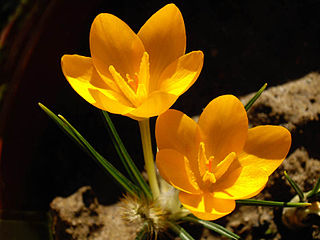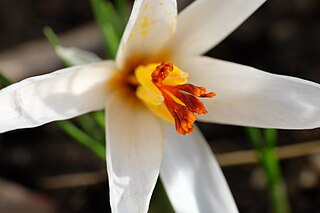
Crocus is a genus of seasonal flowering plants in the family Iridaceae comprising about 100 species of perennials growing from corms. They are low growing plants, whose flower stems remain underground, that bear relatively large white, yellow, orange or purple flowers and then become dormant after flowering. Many are cultivated for their flowers, appearing in autumn, winter, or spring. The flowers close at night and in overcast weather conditions. The crocus has been known throughout recorded history, mainly as the source of saffron. Saffron is obtained from the dried stigma of Crocus sativus, an autumn-blooming species. It is valued as a spice and dyestuff, and is one of the most expensive spices in the world. Iran is the center of saffron production. Crocuses are native to woodland, scrub, and meadows from sea level to alpine tundra from the Mediterranean, through North Africa, central and southern Europe, the islands of the Aegean, the Middle East and across Central Asia to Xinjiang in western China. Crocuses may be propagated from seed or from daughter cormels formed on the corm, that eventually produce mature plants. They arrived in Europe from Turkey in the 16th century and became valued as an ornamental flowering plant.

Crocosmia (;), also known as montbretia, is a small genus of flowering plants in the iris family, Iridaceae. It is native to the grasslands of southern and eastern Africa, ranging from South Africa to Sudan. One species is endemic to Madagascar.

Crocus flavus, known as yellow crocus, Dutch yellow crocus or snow crocus, is a species of flowering plant in the genus Crocus of the family Iridaceae. It grows wild on the slopes of Greece, former Yugoslavia, Bulgaria, Romania and northwestern Turkey, with fragrant bright orange-yellow flowers. It is a small crocus (5–6 cm, despite the names of some cultivars, compared to the giant Dutch crocuses. Its cultivars are used as ornamental plants.

Crocus sieberi, Sieber's crocus, also referred to as the Cretan crocus or snow crocus, is a plant of the genus Crocus in the family Iridaceae. A small, early blooming crocus, it easily naturalises, and is marked by a brilliant orange which is mostly confined to the stamens and style, fading through the bottom third of the tepal. It grows wild generally in the Balkans: Greece, especially in the island of Crete, Bulgaria, Albania and North Macedonia. There are four subtypes: sieberi (Crete), atticus, nivalis and sublimis. Its cultivars are used as ornamental plants. Height: 3–4 inches (7.6–10.2 cm).

Crocus tommasinianus, the woodland crocus, early crocus, or Tommasini's crocus, is a flower named after the botanist Muzio G. Spirito de Tommasini (1794-1879). It is native to Bulgaria, Hungary, Albania, and the former Yugoslavia. It is often referred to as the early or snow crocus, but these terms are shared with several other species, although C. tommasinianus is amongst the first to bloom. Multiple plants are often called tommies in the horticultural trade.

Tecophilaea cyanocrocus, the Chilean blue crocus, is a flowering perennial plant that is native to Chile, growing at 2,000 to 3,000 m elevation on dry, stony slopes in the Andes mountains. Although it had survived in cultivation due to its use as a greenhouse and landscape plant, it was believed to be extinct in the wild due to overcollecting, overgrazing, and general destruction of habitat, until it was rediscovered in 2001.

Crocus ligusticus is a herbaceous perennial plant belonging to the genus Crocus of the family Iridaceae. The genus nane Crocus is a Chaldean name meaning "saffron", while the specific Latin name ligusticus, meaning ligurian, refers to the distribution area of this species.
Brian Frederick Mathew MBE, VMH is a British botanist, born in the village of Limpsfield, Surrey, England. His particular area of expertise is bulbous plants, particularly ornamental bulbous plants, although he has contributed to other fields of taxonomy and horticulture. He has authored or co-authored many books on bulbs and bulbous genera which appeal to both botanists and gardeners, as well as specialist monographs on other genera, including Daphne, Lewisia, and Helleborus. His work has been recognized by the British Royal Horticultural Society and the International Bulb Society.

Crocus angustifolius, the cloth-of-gold crocus, is a species of flowering plant in the genus Crocus of the family Iridaceae, native to southern Ukraine and Armenia. It is a cormous perennial growing to 5 cm (2.0 in) tall and wide. The narrow grass-like leaves with silver central stripe appear in late winter or early spring. They are followed by bright yellow fragrant flowers with maroon blotches on the outer petals.

Crocus biflorus, the silvery crocus or scotch crocus, is a species of flowering plant in the family Iridaceae. It is native to south-eastern Europe and south-western Asia, including Italy, the Balkans, Ukraine, Turkey, Caucasus, Iraq, and Iran. It is a cormous perennial growing to 6 cm (2.4 in) tall and wide. It is a highly variable species, with flowers in shades of pale mauve or white, often with darker stripes on the outer tepals. The flowers appear early in spring.

Crocus etruscus is a species of flowering plant in the genus Crocus of the family Iridaceae, endemic to woodlands of Central Tuscany (Italy). It is a cormous perennial growing to 8 cm (3.1 in) tall. The lilac flowers with purple veining and prominent orange stigmas appear in early spring.

Crocus ancyrensis, sometimes known as the Ankara crocus, is a species of flowering plant in the genus Crocus of the family Iridaceae, endemic to North and Central Turkey. It was named ancyrensis as it was first discovered in Ankara.

Crocus malyi, the Maly crocus, is a species of flowering plant in the genus Crocus of the family Iridaceae, endemic to Croatia.

Crocus nudiflorus is a species of flowering plant in the genus Crocus of the family Iridaceae. It is an autumn-flowering, dwarf, deciduous perennial found in western Europe from southwestern France to Spain. It has been cultivated since Tudor times in Great Britain, where it is now naturalized.
Crocus brachyfilus, synonym Crocus elegans, is a species of flowering plant in the genus Crocus of the family Iridaceae. It is found in Turkey.

Crocus ochroleucus is species of flowering plant in the Iridaceae family. It is a cream-colored crocus native to Lebanon, Palestine and Syria.

Crocus fleischeri is a species of flowering plant in the genus Crocus of the family Iridaceae. It is a cormous perennial with a native range from the eastern Aegean Islands to western and south western Turkey.

Crocus alatavicus is a species of flowering plant in the genus Crocus of the family Iridaceae. It is a cormous perennial native to Kazakhstan, Kyrgyzstan, Tajikistan, Uzbekistan, and Xinjiang.

Crocus dalmaticus is a species of flowering plant in the genus Crocus of the family Iridaceae. It is a cormous perennial native range is from the north western Balkan Peninsula to northwestern Albania.

Crocus gargaricus is a species of flowering plant in the genus Crocus of the family Iridaceae. It is a cormous perennial native to Turkey.


















